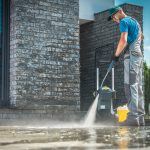Mould – that fuzzy, unwelcome guest that sneaks into our homes and dampens our spirits. Most of the time, we view them as elements that destroy the beauty and curb appeal of our homes. However, these are more dangerous than we think. Many types of moulds are capable of causing severe allergic reactions and also cause harm to internal organs. Therefore, it’s essential to search for professionals performing mould removal near me and get rid of these as soon as possible.
Understanding the moulds and knowing households’ methods to get rid of them is an added advantage. With this blog, we want you to have that upper hand and eliminate these pesky problems from your residence. Let’s begin-
10 Different Types of Moulds
Here is an overview of the most common household mould and the health issues these causes.
Acremonium
If there are waste building materials lying around in the compound, acremonium mould will find it the best place to make a home. One can spot it on damp building materials, posing a risk to humans and pets. If the mould stays there for a significant time, it can cause respiratory issues in the surrounding people.
Alternaria
Alternaria is a common outdoor mould that can find its way indoors. You can find these on the window pane, glass ceiling and other such places. It also loves damp areas like showers and leaky sinks. Fiberglass roof cleaning professionals can help you get rid of these. These are less harmful than other moulds. However, they can still trigger allergies and asthma symptoms.
Aspergillus
This mould is a frequent flyer in airborne spores. It thrives in organic materials. Therefore, it is a threat to those with weakened immune systems. Timely removal is essential to prevent health complications.
Aureobasidium
Aureobasidium is a colourful character, often pink or black, found on wooden surfaces, painted walls, and even behind wallpaper. It’s known for causing skin and nail infections, making its elimination crucial.
Claetomium
Claetomium loves water-damaged spaces, growing on damp drywall and insulation. You can recognise its presence through an irritating musty odour that will be present in the neighbouring spaces. If you haven’t opted for mould removal near me to eliminate Claetomium, these might lead to skin and nail infections, demanding quick action.
Cladosporium
Cladosporium is an adaptable mould, thriving in both warm and cold conditions. It’s mostly present on fabrics, carpets, and wood surfaces. While it’s not the most harmful, it can still trigger hay fever symptoms.
Fusarium
Fusariums are particularly fond of humid environments. It’s present on water-damaged carpets and fabrics. It might not be a household name like some moulds, but its mycotoxins can pose health risks.
Mucor
Mucor, with its rapid growth, can swiftly take over damp or wet areas. It’s a common invader after floods and leaks. While it might not be as harmful as some, those with allergies need to be cautious.
Penicillium
Yes, you’re thinking right. It’s the same mould that gives us a life-saving antibiotic. However, there are multiple species in the same category that can cause allergies. These are often blue or green and are prevalent in various materials, including food.
Stachybotrys
Stachybotrys, infamous as “black mould,” prefers constant moisture and cellulose-rich materials. It can trigger asthma and other hypersensitivities.
Different Ways to Remove Mould
Professionals performing mould removal near me suggest a few household ways to eliminate these from the premises. Below are a few of these-
Bleach
Bleach, a potent mould destroyer, can effectively eliminate mould from non-porous surfaces. A mixture of one part bleach and four parts water works great in eliminating mould. Remember to wear protective gear and ensure proper ventilation.
Hydrogen Peroxide
Hydrogen peroxide is a gentler alternative for mould removal. It works well on porous materials and doesn’t even leave any harmful residue. Use a 3% concentration solution and let it sit for 10 minutes before scrubbing.
Vinegar
Vinegar, a kitchen staple, is also a handy mould fighter. Its acidic nature can dissolve mould, especially on non-porous surfaces. Undiluted white vinegar is your go-to for tackling mould.
Baking Soda
Baking soda doubles as a cleanser and deodoriser, making it a dynamic mould remover. Create a paste with water, apply it to the affected area, scrub, and rinse. It’s safe for both you and the environment.
Professional Help
For extensive mould infestations, seeking professional assistance is wise. Fiberglass roof cleaning experts can look into the situation and provide solutions. They will also provide remedies to prevent recurrence.
Tips to Prevent Mould Formation
Here are a few tips to keep moulds away from your abode-
- Keep indoor humidity levels between 30% and 50%.
- Fix leaks and water-damaged areas promptly.
- Ensure proper ventilation in bathrooms, kitchens, and basements.
- Use exhaust fans to reduce moisture in high-humidity areas.
- Direct water away from your home’s foundation with proper drainage.
- Regularly clean and dry areas prone to dampness.
- Consider using a dehumidifier in moisture-prone spaces.
- Avoid carpeting in areas with high moisture potential.
- Store belongings in well-ventilated spaces, especially in damp seasons.
- Insulate your home properly to prevent condensation.
In a Nutshell
Once we are abreast with the different mould types and household ways to eliminate them, it becomes easier to tackle these. If nothing works, you always have the professional team from Exterior Clean Melbourne to your rescue. They use the best tools to remove moulds and provide you with a safer house. Their expert tips will also keep the moulds from returning.



